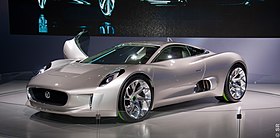JAGUAR C-X75

 | |
| Manufacturer | Jaguar |
|---|---|
| Production | Cancelled |
| Class | Sports-prototype |
Jaguar C-X75 is an hybrid-electric, two-seat, concept car from Jaguar which debuted at the 2010 Paris Motor Show. The C-X75 concept produces 778 horsepower through four electric motors, each of which drives one of the four wheels. The batteries driving these motors are recharged using two diesel-fed micro gas turbines instead of a conventional four-stroke engine.[1] It is described as an ideas model that will influence future design and technology.[2]
The C-X75 was named in honour of Jaguar’s 75th anniversary, the C stands for concept and the X for experimental.[1][3]
In May 2011 Jaguar announced plans to build a limited production of the Jaguar C-X75, with a downsized, boosted petrol engine instead of the micro gas turbines in the concept, from 2013 until 2015. The plug-in hybrid supercar price was estimated between GB£700,000 - GB£900,000 (US$1.15 - US$1.48 million) depending on local market and taxes. A maximum of 250 cars were planned to be built in partnership with Formula One team Williams F1. The production version was expected to have an all-electric range of 50 km (30 mi).[4][5] In December 2012 the carmaker announced the cancellation of production due to theongoing global economic crisis.[6]
[edit]
 Engine and performance
Engine and performance
In terms of performance, Jaguar envisions future super cars reaching 330 km/h (205 mph) and accelerating from 0 to 100 km/h (0 to 62 mph) in 3.4 seconds and 80 to 145 km/h (50 to 90 mph) in 2.3 seconds. It is powered by four 145 kW (194 hp) electric motors – one for each wheel - which produce 780 hp (582 kW) and a total torque output of 1,600 N·m (1,180 lbf·ft). Inherent in the drivetrain is the ability to independently vector torque to each wheel across the full speed range.[3][7] Each motor weighs 50 kilograms (110 lb).[2]
The micro gas turbines from Bladon Jets generate enough electricity to extend the range of the car to 900 km (559 mi) while producing 28 grams of CO2 per kilometre on the EU test cycle. While running solely on battery power, the C-X75 has an all-electric range of 110 km (68 mi).[3][7] Among other advantages, the micro turbines used in the C-X75 can be run on a range of fuels including diesel, biofuels,compressed natural gas and liquid petroleum gas.[7] The 15kWh lithium ion battery pack weighs 185 kilograms (410 lb).[2] Jaguar estimates an average carbon emission of 28 g/km on European test cycle, however, the carbon emission is around 150g/km if the turbines are running.[8]
Jaguar also focused on the aerodynamics in order to improve performance. For example, the carbon-fibre rear diffuser that guides airflow from under the car creating down-force, and includes an active aerofoil and is lowered automatically as speed increases. Moreover, the C-X75 features an extruded and bonded, aerospace-inspired, aluminium chassis, saving on weight and improving sustainability and performance.[7]
[edit]Production
In May 2011 Jaguar unveiled plans to build a GB£700,000 (US$1.15 million) petrol-electric plug-in hybrid supercar in the UK. The carmaker planned to build a maximum of 250 cars in partnership with Formula One team Williams F1. The decision was part of a GB£5 billioninvestment plan, announced by Jaguar Land Rover (JLR) in March 2011 at the Geneva Motor Show, to launch 40 "significant new products" over the next five years. The model was scheduled to be built from 2013 until 2015, although it had not yet been decided where production would take place.[4][5]
The C-X75 was to be built without the diesel-powered micro-turbines, instead, the production version would use a downsized highly-boosted petrol engine with one electric motor at each axle. In order to create a lightweight strong structure, the chassis was planned to be made of carbon-fibre, and the engine would be mounted low for optimum weight distribution and to retain the concept’s silhouette. The C-X75 production version was expected to deliver CO2 emissions of less than 99 g/km, a sub-three second 0-60 mph time, a top speed in excess of 200 miles per hour (320 km/h), and a reduced all-electric range of 50 km (31 mi) as compared to the 110 km (68 mi) for the concept car.[4]



0 comments: